By Gaulbert Sutherland
Photos by Arian Browne
At the RH Hotel in Mahdia, it is easy to believe that you are on a Caribbean island. The splendid pool, the bar, the ambience of the enclosed compound under the soft, purple lighting makes one forget the outside world of dusty streets and rusty buildings.
Hidden away much like the gems in the goldfields that surround the Region Eight (Potaro/Siparuni) community, the hotel is an oasis amidst the rush and bustle of a gold boomtown. A mining community is what Mahdia is known as, but intriguing possibilities arise once you have experienced the expanding community. Creole, Brazilian and Chinese restaurants as well as numerous snackettes offering various foods dot the community and the nightlife is vibrant with clubs and bars specializing in dancehall, Brazilian, reggae and other music. Throw in a few tours to places of interest such as an actual gold mine and Mahdia could be another tourist attraction. Who knew?
Despite its recent growth, Mahdia is still essentially a men’s town, with males from the surrounding goldfields making up the majority of customers to the businesses and bars. At dawn, with mist slowly rising off the dusty streets, the late night revellers can be seen making their way home while the early risers get ready for work, mostly in the goldfields. All males with only one skimpily-clothed woman in long boots slowly walking down the road amid catcalls.
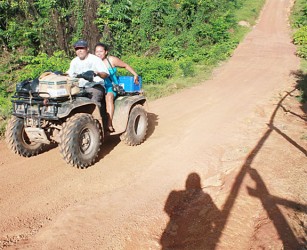
goldfields surrounding Mahdia.
Mahdia is a community of migrants, mostly internal, but descendents of Caribbean islanders and more recently, Brazilians, make the community their home as well. Established by Africans from the coast in 1884, for over 100 years Mahdia was the refuge of those determined to create their dream of a better life. Among those who arrived were many who could not find a job elsewhere. First it was the Africans from Berbice and the East Coast Demerara, then the British and islanders from the Caribbean and these days, Guyanese from across the country and Brazilians.
The community is surrounded by the scenic Pakaraima Mountains and encircled by the jungle. Mahdia is the perpetual mining town, its fortunes rising and falling with the price of gold and diamonds.
Rapid development has taken place over the last few years due to the mining boom and the town continues to attract more and more people. “I do a little better business here than in town,” said Marilyn Martin, sitting, dark shades on, in the shadow of her temporary stall just outside the Mahdia Secondary School. She started selling in October and for the past two months rented a place so that she could be there longer. Her only grouse was that the regional officials do not want her to build a more permanent structure and so, nightly, she has to move her goods.
Business is ok, she said, watching as persons walk slowly in the humidity of the hot noon sun. “I try to sell just how you normally sell in town. I don’t put in too much price,” Martin said. Her story is much like the story of others in the community: come to town, set up shop and send back money to family left behind. She said that her being in Mahdia is strictly business and she even finds the community “lil boring.”
“I feel Mahdia is strictly for business, you could do business,” she nods. “I does sell reasonable and I does get through.”
Robert Stanisles popularly known as ‘Brother Sam’ had a different reason for coming back. A St Lucian by birth, he now holds dual citizenship. He oversees the
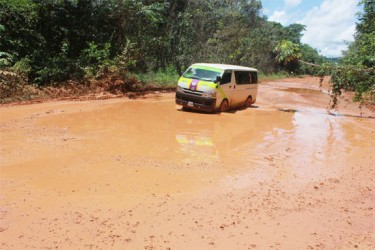
Roman Catholic congregation at the Catholic Church in Mahdia. “Long ago, Mahdia was seen as an islander place, not now,” he said, recalling when persons from the Caribbean

islands came in droves to work in the goldfields. “Some people tell you if you dig any place, you will get gold,” he recounted one of the legends of the famed goldfields.
He said that the community is a peaceful place and it has grown over the years. In the early days, due to the small population, it was “no place to idle” since everyone knew everybody, he said. “Things develop a lot. There is a lot of changes as you see now,” he added.
Gold made Mahdia. Following the discovery of the precious mineral, the British Guiana Consolidated Goldfields mining company in then British Guiana, expanded exploration and colonial administrative offices were set up in the community. But up to the early 1930s Mahdia was only accessible by waterways and it was not until November 1933 that a bridge was built over the Garraway stream, linking Mahdia to Bartica by trail. Suspended by cables, the bridge, which still stands today, was named Denham Bridge after the then colonial Governor, Sir Edward Denham. The bridge could be a tourist attraction, Stanisles said.
In the last decade, Mahdia began to grow rapidly. The sprawling Potaro-Siparuni Region is administered from here. It is eight hours from Georgetown by minibus on a laterite road or about an hour by small aircraft. There is running water, telecommunication services, a post office, nursery, primary and secondary schools, a police station, a hospital, an airstrip, restaurants, fuel stations and a commercial district where “you can get everything.” Over the last year, a state-owned electricity plant was provided by the state and the community receives electricity from mid-day to 6am.
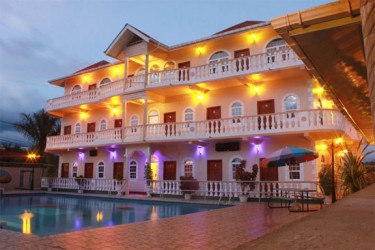
One of the anomalies of Mahdia is the way it is administered. The community is overseen by the regional administration and has never had local government elections, Stanisles
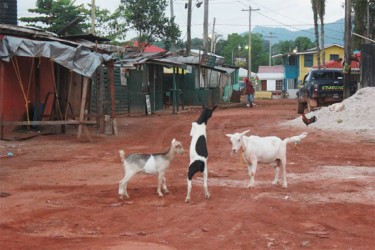
said. He added that it is not technically a village, landing or town. “I cannot say what we are,” he added with a chuckle. He said that he feels that the lack of local government elections has “let down” a lot of things in Mahdia.
Stanisles’ Guyanese journey began in 1968 when he arrived in the country. He said at the time persons were asking about roads, a good water supply and electricity and they still have the same concerns today. He opined that the Bartica-Potaro road would be a better option that the current road from Linden through Mango Landing because it is more flat and sandy. He said that once Garraway stream is beautified, it can become a tourist attraction. “Dat thing just deh in the bush deh,” he stated.
Stanisles spent 24 years in Guyana before returning to St Lucia in 1992. “God send me here to do church work,” he said. The man returned in 2002 after visiting in 2001 being requested by residents and the church in the person of then Bishop Benedict Singh to return. He is currently in charge of the Catholic community in Mahdia in the absence of a priest.
Living in Mahdia is a good experience for someone to learn, Stanisles said. He said that everyone respects him and he has no problems with anyone and believes that all should live as human beings. Stanisles got married here and his wife died in 2003. As to whether he would return to St Lucia, he said that this is an open question. “I leave it open… anything can happen,” he said with a smile. “God will decide.”
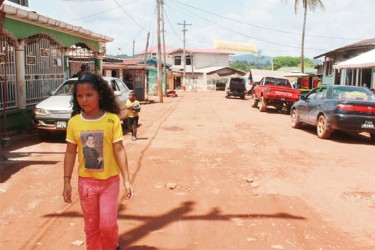
Meanwhile, one of the issues that residents have in Mahdia is the cost of living. Apart from the cost of transporting goods to the community, the presence of the goldfields also ensures that prices are inflated. However, some say that they have gotten used to it.
Mining is the lifeblood of the community and these days the mines are closer to the community and roads leading to the community. Many of the streams are polluted with water
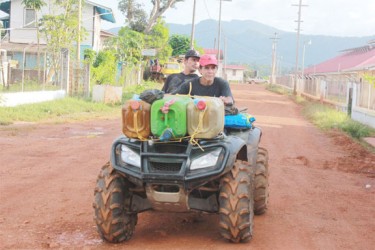
ranging from yellowish to milky.
About 2600 persons now reside in Mahdia and the neighbouring community of Campbelltown, said a regional official. She said that the hospital is staffed with two Cuban doctors and a Guyanese doctor. The services are good but can be better, she said. The official said that malaria and dengue fever are common in the community. For typhoid, a private facility offers testing and treatment. The official noted that the World Health Organisation has said that Guyana does not have typhoid but instead it is a bacterium that is causing the typhoid-like illness.
Mahdia is quiet and there are four Christian churches and a mosque in the community. Following a devastating fire that razed a major portion of the business district three years ago, a fire tender has been purchased while popular businessman Roger Hinds has also purchased one.
Mahdia continues to grow. Numerous stalls, shops, bars, restaurants and guest houses line the streets. Nightly, dozens of hungry miners roam the ‘line’ in search of dinner and entertainment and the smell of ‘weed’ is only a whiff away.

Out by the poolside of the RH Hotel, all is quiet, a sea of tranquility in the bustle of Mahdia. It has a new wing and the original rooms are undergoing renovation. Like Mahdia, it is a hidden gem, waiting to be discovered.




